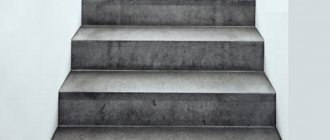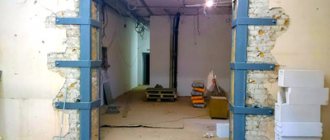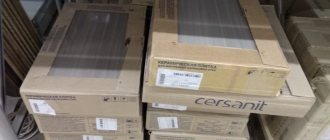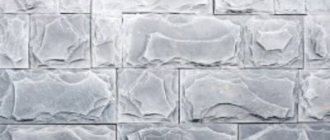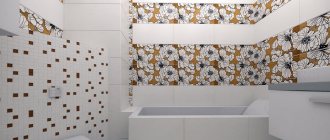Finishing a house, cottage, building or office with decorative concrete facade tiles not only has an aesthetic purpose, creating a unique style for the building, but also provides additional insulation from the outside, as well as protection from adverse external factors (temperature changes, natural disasters, water, rodents).
Facade tiles have different shapes, dimensions, are divided into types, and are attached to construction glue or frame. How to choose products, what regulatory requirements apply to them, what you need to know about installation, advantages, manufacturers and prices - read more in this article.
Description of concrete products
Wall cladding with concrete tiles is the use of products of various sizes and shapes in finishing :
rectangular, square;- under brick (smooth, old);
- natural stone (chipped, rubble, Crimean, etc.).
The presented products are produced in a wide range of colors, which allows you to choose the most suitable design for any building.
The tiles are made by pouring in special forms, without firing, from durable cement grades M400 and M500, but they are classified as lightweight concrete due to the introduction of polymers and binder fillers. Additives help make tiles resistant to :
- moisture;
- frost;
- UV rays;
- mold;
- natural;
- mechanical influences.
In addition to the base – cement, the composition of concrete contains screenings:
- quartz sand;
- granite;
- marble chips.
The standard dimensions of the facing material are 240 x 52-62 (mm) , but there are also large-format products - 400-486 x 71-115 (mm). Square and corner shapes of products have individual dimensions and are made to order.
Unlike clinker tiles and artificial stone, cement products for facades are considered more affordable and are produced under ergonomic production conditions.
Regulatory Requirements
Facade cement products are manufactured and used in accordance with the basic technical regulatory rules of GOST:
- GOST 6927-2018
- GOST 13996-93.
According to these documents, cement tiles for cladding must meet the following requirements :
- Products are manufactured according to technical drawings, in forms that separate them by texture and dimensions.
- The layer thickness must be at least 15 (mm).
- The compressive strength indicator must correspond to class B15.
- Reinforcement with steel wire with anti-corrosion coating, cold-tensioned class (B500) is allowed.
- The width of the seam between the tiles should not exceed 4-8 (mm).
- For production, concrete grades M400 and 500 are used.
- All building materials used in production must meet current quality standards.
- It is allowed to finish the front tile part with polymer-cement mortars and other compositions resistant to atmospheric changes.
The standards draw attention to the fact that the surface of the products (smooth or with figured inclusions) must correspond to each other. The permissible difference between the laid tiles should not be more than 1 (mm).
Manufacturers are allowed to mark cement facade tiles from the inside. The marking includes an indication of the concrete class, permissible strength and frost resistance index F (standard 75-150).
Composition of decorative concrete
Mix everything until creamy, or preferably a little thicker. Apply several layers to the wall, depending on the thickness of the elements. If the entire thickness is applied at once, the concrete will float.
Do not prime the surface before applying concrete to the walls.
How to make architecture from concrete
Concrete products are quite easy to make. All you need is imagination. First you make a frame, for example, of the same garden bench. Next, you need to attach the mesh to it. Apply concrete to the mesh - it will serve as a reinforcing agent. If thick elements are provided, then apply the mixture in several layers after the previous layer has dried.
Types of finishing products
Concrete products make it possible to beautifully cover the entire façade of a building, including the basement. Facade tiles vary in :
texture;- form;
- dimensions;
- blossom.
But all varieties have the same internal structure :
- poured into shape;
- with or without reinforced mesh;
- single-layer;
- two-layer;
- molded or obtained after pouring, by sawing.
Product classification divides tiles into the following groups:
- By invoice:
- smooth (the finished form is ground and polished);
- embossed (the shape has a special outline, sawing and corrugation are carried out).
- By shape:
- brick (made antique or with a smooth surface);
- stone (rubble, polished, sawn, chipped, Crimean, slate).
- By color:
- with the introduction of pigment into the molding mixture during mixing;
- using paint during pouring, covering the surface after laying in the mold;
- painting with the selected shade after installation.
- By installation method:
- wet (with adhesive solution);
- dry, on a frame made of wood or metal, using construction fasteners (screws).
- According to the tile production method:
- standard (usual cold pouring and distribution into shape manually or mechanically, with drying at normal air temperature);
- vibrocast (poured in a factory, with vibration of the solution using a special tool);
- vibration-pressed (completely similar to vibration-cast products, but with the additional use of pressure).
Regardless of the type, any type has a number of advantages due to its composition, the basis of which is cement - a mineral substance that, in combination with other elements and polymers, forms a plastic mass with high strength and density characteristics and sufficient sound and noise insulation.
Facade concrete tiles are decorative elements of the house that perform aesthetic, protective functions and an additional thermal insulation layer on top of the main insulating layer.
Using a vibrating table
A vibrating table is a structure consisting of a metal frame, a tabletop on which forms are then placed, and a vibrating engine.
Place the molds on the countertop, turn on the engine, and the pouring mass is distributed over the mold due to vibration. A greater density of the solution is achieved, and, consequently, strength.
Question: Is it necessary to use a vibrating table?
Answer: you can do without a vibrating table. Use the manual vibration method: tap the form with the mixture on a level base so that the concrete solution is distributed throughout the form.
When vibrating manually, be sure to use plasticizers. To save money, you can make a vibrating table yourself.
What buildings is this method suitable for?
Facade concrete tiles are suitable for all types of buildings :
offices;- institutions;
- primary and secondary housing (monolithic, brick, gas-block, foam concrete, SIP-panel, and even wooden).
The last buildings (made of logs) are decorated as desired. More often, tile products are used only for the basement of houses.
Facade finishing is an original architectural solution made from high-quality, durable building material. Imitation of a plinth or structural (external) walls imitating natural stone or brick gives a special texture to any vertical surface. There is also a type of wood finish, in any color, which is made to individual orders.
How can you use architectural concrete?
Architectural concrete VII MIRACULA is used for the following types of work:
- finishing of facades of buildings and structures;
- interior decoration of residential and commercial premises;
- design of decorative ponds;
- creation of artificial waterfalls;
- creation of decorative rocks;
- creation of retaining walls;
- creation of garden and park sculptures.
Products made from architectural concrete are especially good due to the ability to imitate the texture of other, aesthetic, but less practical and workable materials: natural stone, metal, wood.
No real iron, brass or stone were used in this interior. Even the rivets are made from architectural concrete
Photo: viimiracula.ru
Art concrete in interior decoration
Art concrete is widely used for interior decoration. With its help, you can create decorative panels, apply images and ornaments, imitate unusual masonry when decorating walls, and decorate columns and arches.
Bathroom and kitchen countertops and washbasins are made from architectural concrete. You can decorate the hall in your house with a beautiful stone fountain.
A private house, country club or other premises can be turned into a grotto or an ancient castle. And at the same time, install hidden communications so that the house remains a modern home with familiar amenities.
An interior made of architectural concrete is suitable for premises for a wide variety of purposes, including those with high humidity. The material is also in demand for outdoor work, as it tolerates exposure to ultraviolet rays and frost well.Photo: viimiracula.ru
Art concrete in facade finishing
Architectural concrete for the facade allows you to either complement an existing style solution or create a completely new concept. You can do without major alterations by refreshing the appearance of the building by decorating the plinth or entrance area, creating relief sculptures in the form of people, animals, and various figures. This is exactly what we did when decorating the facade of a country house in Starville.
With the help of architectural concrete, you can either implement a project for a new house or completely renovate the façade of an existing one. You can complement the facade with various panels, three-dimensional drawings, mosaicsPhoto: viimiracula.ru
Construction of architectural objects from art concrete
Architectural objects made of art concrete are used in landscape design and interior decoration. Architectural forms can be large or small. Big ones include retaining walls, waterfalls, rocks, artificial trees and sculptures. For small ones - benches, flower beds, flowerpots, rockeries, Japanese rock gardens.
Objects made of architectural concrete can be either purely decorative or have a functional valuePhoto: viimiracula.ru
Waterfalls
An artificial waterfall is part of the overall composition and complements the landscape or interior of the room. Waterfalls vary in size and can be single-tiered or multi-tiered. Depending on the settings, water can fall at a certain speed. Often the composition is complemented by lighting.
Waterfalls made of art concrete will look harmonious both in the garden of a private home, and near a cafe, restaurant or other commercial facilityPhoto: viimiracula.ru
The shapes of waterfalls can be very different. Designs made of stones of different sizes and irregular shapes are more reminiscent of natural ones. Waterfalls made of regularly shaped stones with neat edges look more like unusual fountains or springs.
Rocks
In the interior decoration, rocks are harmoniously combined with different interior trends: classic, modern, loft, country.
In landscape design, rocks go well with waterfalls, stone walls, benches, gazebos and other small and large architectural forms.
Our craftsmen worked with a variety of original solutions. For example, the entrance to the diving club was designed in the form of a cave. The stones are as detailed as possible, the stairs have handrails made of ropes.
Art concrete rocks can be quite miniature or more massive. You can create a retaining wall on the site that will imitate rock.Photo: viimiracula.ru
Artificial trees
Architectural concrete products can be small in size. Despite this, they attract attention and allow you to diversify the interior. Trees can be made either free-standing or presented in the form of bas-reliefs. Artists recreate in detail the natural texture of bark, branches, and leaves.
Trees made from architectural concrete are highly detailed and realistic. The bark, branches, and vegetation are painted with special paints, and the relief is achieved thanks to the plasticity and pliability of the material.
Photo: viimiracula.ru
Sculptures
Landscape sculptures can be round, that is, three-dimensional. They are freely placed in space and viewed from all sides. They can be in relief - this is a three-dimensional image on the facade of a building, wall or other flat surface.
Sculptures can be presented in the form of human figures, animals, birds, plants. We supplemented the caves in the project in the Dreamwood Wonder and Adventure Park with sculptures. Convex semi-volume sculptures are located directly on the rocks. Inside the cave there is a sculpture of a mammoth skull with tusks.
Sculptures allow you to place all the necessary accents. They bring harmony and fit perfectly into the existing image.Photo: viimiracula.ru
Retaining walls
Decorative concrete is used to create retaining walls because it can withstand heavy loads and does not collapse or deform. A retaining wall can be used to zone interiors and delimit the territory of a garden plot.
Load-bearing walls made of architectural concrete also perform other useful functions. They prevent soil from being washed away by rainwater and serve as protection for embankments, soil, flower beds, and terraces from destruction.
Retaining walls made of art concrete are both a decorative element and allow you to delimit and zone spacePhoto: viimiracula.ru
Rules for choosing cladding material for the facade
When purchasing products, you need to pay attention to the manufacturer and reviews about it. Also, when choosing, you need to consider the following nuances :
- Texture. Smooth products are less exposed to dust, textured ones will require more thorough cleaning.
- Color. The design of the building should evoke a pleasant feeling of natural tones.
- Packaging integrity. Manufacturers indicate the number of products in the instructions, which must match the actual number. The durability and degree of water absorption of the tiles, which normally should be no more than 5% for the base and no more than 9% for the walls, depends on the integrity of the packaging (usually polyethylene).
- Compliance of products with each other in shade, shape and texture.
- Product composition. Must be signed in detail in the quality certificate and in the instruction attachment.
- Marking. Conscientious manufacturers must indicate the alphanumeric designation of the building material used in the accompanying documents, as well as on its inner surface.
Feedback from experts and users also matters. On the official websites of manufacturers, as well as social construction sites, it is worth finding out a real opinion about the quality and operation of products.
Advantages and disadvantages of products
Concrete tiles are not without advantages and disadvantages.
And despite its global reach, it still has some yard owners wondering about using alternative materials. Let's figure out whether its shortcomings are so terrible?
Pros of concrete tiles
Let's start with the pros:
- A huge selection of shapes and sizes, thanks to which you can create unique designs that can decorate any area
- High level of resistance to biological and climatic influences, including sudden temperature changes.
- Relatively low cost of production
- Concrete tiles are slightly susceptible to abrasion and can easily withstand mechanical loads
- The material is environmentally friendly, which is especially important for the realities of our time.
- Easy to install, replace and repair.
Simply put, concrete tiles have all the qualities necessary for long-term and comfortable use, and meet the requirements of economy and practicality.
Concrete tiles dimensions
Disadvantages of products
Of course, we cannot do without negative sides.
They boil down to the following:
- When producing tiles using the vibration casting method, the products are very slippery, so their scope of application is quite limited for safety reasons.
- Often the service life of tiles is slightly shorter than what the manufacturer claims. This fact occurs if the tiles are manufactured in a region whose climate is different from the weather conditions in the city receiving the product.
- If installation errors occur, they are difficult to correct. The tiles may be subject to deformation, cracks and serious shrinkage.
On this, the disadvantages are limited and, as you can see, there are much more advantages. And if you look not at the quantitative, but at the qualitative component, then the negative sides may not be noticed at all under the influence of justified advantages.
TOP best manufacturers
Let's look at the 7 most famous brands.
TechnoNIKOL
The Russian company is focused on the quality and practicality of facade cladding. The products are resistant to fading in the sun and frost, do not allow water to pass through, are durable and easy to install. The price of products is from 400 rubles/m2.
Grand Line
It produces elite cladding for cottages and low-rise buildings, in different textures and shades. The quality of products is tested in the company’s own laboratory and is indicated in the accompanying documents. The price of the products is 1000 rubles/m22.
VOX
Tiles from the manufacturer are suitable for use at extremely low and very high temperatures. They have window products (profiles) that have no analogues. The company specializes in wood-look siding, which is highly dense and durable. The price of the products is 600 rubles/m2.
Döcke
German siding from 800 rubles/m2 is characterized by impeccable quality and durability. The products are presented on the Russian market in 38 color options and six textures (varieties of natural stone and brick).
Nichiha
The Japanese company produces its products for consumers around the globe. The main feature of construction products is a large assortment of series made in the style of:
- Fuge;
- COOL;
- ART;
- natural stone.
The material has high density and strength characteristics, a nanohydrophilic coating and resistance to mechanical stress. The price of products is from 800 rubles/m2.
Nailite
The American manufacturer allows you to select products online from anywhere in the world. To do this, the presented line of natural siding (stone) is selected to match the selected house layout.
Each user can choose in the program what suits him , trying out options, just like in a game. The products have high quality characteristics and guarantees. The price of products is from 680 rubles/m2.
Alta-Profile
Domestic products from this manufacturer are intended for all regions, but are especially recommended for areas with sub-zero temperatures reaching up to -60°C.
Concrete tiles are presented in a large range of models in texture and color, do not overload the facade, and are made with multi-stage quality control. The price of products is from 500 rubles/m2.
Modern interior design with terrazzo flooring
They are recommended to be installed in non-residential areas, such as a corridor, living room, kitchen or bathroom. In the bedroom, this tile does not look very good, and it can also be cold to the touch. You can lay tile products on the floor and also fill them if necessary. Some owners do even more interesting things. They ask for tiles to be laid, and a polyurethane coating is poured on top. It is not cheap, but it is the path to maximum durability. There are many options, you just need to choose the most suitable one.
Tools and accessories for installation
To install facade tiles, the master will need :
- Container for mixing mortar or glue (for wet installation).
- Construction mixer or drill attachment.
- Laser or regular building level.
- Wide paint brush (2-3 pieces of different sizes), primer.
- Notched and regular spatula, as a rule.
- Rubber hammer, trowel, dry, clean rags.
- Tile cutter (for forming corners).
- Construction cord, tape measure, simple pencil for marking.
- Frame made of aluminum, stainless steel and wood parts (for dry installation).
- Screwdriver (cordless or electric).
- Fasteners (dowel-nails, self-tapping screws, brackets).
During the preparation process, you may also need an industrial vacuum cleaner (to remove dust from the working surface), as well as a plaster mixture and a spatula (or a special mechanical machine - a plastering station), which will create a preparatory layer for installation.
Cladding process
There are 2 main methods for laying concrete tile products on a prepared (cleaned, plastered, primed) surface.
Dry method
It consists of forming a sheathing around the perimeter of the building, which is attached to the wall using special fasteners. The frame is made of any suitable material (metal, wood).
Metal forms are treated with anti-corrosion compounds, and wood forms are treated with polymer and antibacterial impregnation, protecting them from the adverse effects of the environment.
Installation steps include the following steps:
- Marking of the façade surface.
- Fastening the brackets to the places to which the selected profile will be attached.
- The frame is attached to the finished dry surface of the wall (plastered and insulated).
- Then the tiles are mounted to it with fasteners. Work begins from the corners, forming layers, from bottom to top.
- Products intended for the dry method have internal grooves: they are fixed in the sheathing, hung next to the tiles; and also above them, the same products.
- The laser level is used to look at the formed successive layers and the correspondence to the horizontal and vertical lines.
This method is considered fast and “clean”.
In addition, it can be considered an additional method of insulation and ventilation, since it creates an additional air gap, the possibility of laying and securing heat-insulating material. The dry installation method is recommended for light tiles with brick and foam block surfaces throughout the year.
Wet method
Tile products are laid around the perimeter of the building using an adhesive composition. To do this, dry glue prepared in a container is diluted with clean running water, mixed thoroughly and applied with a notched trowel to the inner surface of the tile. The surface dries within 24 hours.
The stages of installation using this method are as follows:
- Wetting the prepared (plastered, primed, dried) wall surface with water.
- Cladding from any corner of the wall is carried out from bottom to top. You can apply glue to the wall, in a layer of up to 7 (mm), and glue the tiles to it, lightly tapping it with a mallet. Or apply the glue directly to the product with a notched trowel, pressing it to the surface for 15-30 (s), for better adhesion.
- A well-applied adhesive solution will appear along the edges of the tile, which can be carefully removed with a spatula, then rubbed with waterproof grout and wiped with a clean rag.
It is advisable to perform the wet cladding method in the warm season for better adhesion of interacting materials.
Instead of glue, it is permissible to use a high-quality cement-sand composition with a polymer additive. For the wet method, it is best to select compounds with high frost-resistant qualities. The surface on which facing work is carried out must be pre-insulated and plastered.
In the instructions for tile products, manufacturers often indicate which method should be used for the construction product.
Methods for laying paving slabs
As in the case of facade tiles, paving tile installation methods can be divided into dry and wet. The difference will also be that in the first, the tiles are installed without the use of liquid solutions. In the second method, the tiles are installed using an adhesive composition.
Laying paving stones on a gravel-sand bed using a dry method
The instructions in both cases are simple:
- It is necessary to prepare a flat surface for installation. To do this, the site is filled with crushed stone, compacted, and then spilled with sand and spilled with water.
- Once the laying pad is ready, you can lay the tiles.
- The elements themselves are laid end to end and tapped with a mallet. The stacking level must be checked regularly.
On a note! Without a serious need, you should not install paving stones on concrete mortar. If any work is carried out or the soil is washed away, this will significantly increase the cost of repairs and its duration.
Possible difficulties and errors
During the installation process, avoiding mistakes will ensure long-term operation of the cladding layer and eliminate the need for repairs.
Therefore, in the process of working with the facade (installation of concrete tiles), the following factors should be absent :
- The use of low-quality tile materials, lathing, glue and cement compounds made not by official companies, but by handicraft industries.
- Poorly leveled surface, insufficient finishing, presence of cracks, potholes and other defects on it.
- No priming with two layers (more glue will be required, adhesion to the surface will be worse).
- Incorrect laying rules (violation of the sequence from the corner, and from bottom to top).
- Failure to comply with temperature requirements.
- Laying wet tile products that have been improperly stored, with a high degree of water absorption.
- Failure to use grout mixtures to form a seal between products.
Compliance with the installation rules and strict adherence to the work stages will not require restoration of the surface years later, since the façade cladding will delight you with its appearance for decades.
Paving slabs
Concrete paving slabs are widely used for the construction of adjacent areas, garden and park paths. Such material without specific processing or complex additives is called paving stones.
In addition to it, concrete tiles with rubber filler, polymer sand and reinforced ones are used for the construction of road surfaces. In recent years, concrete tiles with a three-dimensional pattern have become very popular.
The path is tiled with a 3D pattern
On a note! To obtain a laying material with an anti-slip surface, heat treatment is used, which explains the higher price of this product.
Concrete tiles with rubber filler are used for the construction of sports and children's playgrounds. The composition of this material includes polyurethane, due to which the surface is relatively soft.
Covering with rubber-filled tiles significantly reduces the level of injuries on playgrounds
Polymer sand tiles were developed for areas of northern latitudes, and are a fairly new product. The material is lightweight, but at the same time very durable. A distinctive characteristic of such paving stones is their resistance to significant temperature changes.
Criterias of choice
Before purchasing material for a sidewalk or path, you should determine the load on this area.
In order not to make a mistake with your choice, below are some practical tips for choosing:
- For a summer house or personal plot, tiles up to 3 cm thick are suitable. If you plan to drive through or park a car, the thickness should be much greater.
- When purchasing paving stones, carefully examine the appearance of the surfaces of the material. Even a quick inspection will reveal defects that significantly reduce service life.
- It is worth inspecting not only the working surface, but also the back side. Just on the back, uneven coloring or foreign inclusions will be noticeable, which indicates a violation of the production technology.
On a note! A glossy or overly smooth surface of the blocks may indicate an excessive amount of water was used during the production process.
Price is also an indicator of quality. If the manufacturer claims that the material is frost-resistant, it means that it contains specific additives.
Consequently, the tile itself should have a higher price tag than regular material. In addition, the price of tiles made by vibration pressing is higher than that of cast material.
On a note! High-quality paving stones produce a ringing sound when tapped.
Advantages and disadvantages
The advantages of using the products are considered:
High mechanical strength and density.- Environmental cleanliness (production and subsequent operation).
- Large varied range (in color and texture).
- Ease of transportation, storage and installation.
- No load on the load-bearing surface (light weight).
- Aesthetic appearance (compliance with natural materials).
- Additional protection from adverse external influences (perimeter walls).
- Water resistance, frost resistance, sound insulation.
- Long service life and ease of maintenance.
- Possibility of changing shade over time.
- Availability of the designation “NG” (non-flammable industrial group).
- Low price.
disadvantages to concrete tiles for facades:
- Not suitable for heavy products weighing more than 35 kg/m2.
- Some varieties are not recommended for regions with harsh winters.
You should definitely pay attention to the quality of the tiles when purchasing. Uneven edges and ridges will indicate that the product is of poor quality. Removing irregularities with a saw and grinding will be too time-consuming.
When purchasing products, you must require a certificate for the product.
Components for the production of concrete tiles
It includes:
- cement;
- sand;
- mineral powder - a cement substitute made from ash, ground slag, stone crushing waste, etc., introduced into concrete in a volume of 5-20% to give the concrete special properties (heat resistance, different colors, etc.);
- plasticizing additives - used to increase the mobility of the concrete mixture;
- stabilizing additives - to prevent separation of the concrete mixture;
- water-retaining additives - to reduce water separation.
To achieve good quality cladding of façade walls, it is necessary that they be smooth
Average prices for work
In the Russian Federation, the highest prices for installing tiles, along with surface preparation, are in the cities of Moscow, St. Petersburg, Novosibirsk, as well as some northern regions (up to 2,000 rubles/mm2).
Most construction and contracting companies operating officially have their own websites, where they indicate the price list for the services performed in special sections. You can find them by searching in your region. Official companies always draw up a contract and provide guarantees for the work performed.
Laying concrete tiles as a façade, on average in the Russian Federation, is 1,200-1,500 rubles/m2 . Some contractors and self-employed citizens charge 500-700 rubles/mm2 for installing tiles, and there is no guarantee for the work performed.




